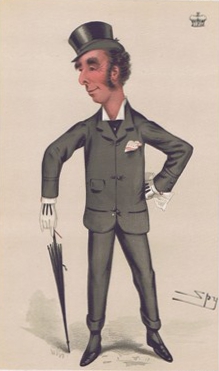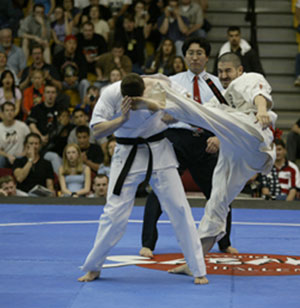
Boxing is a combat sport and a martial art in which two people, usually wearing protective gloves and other protective equipment such as hand wraps and mouthguards, throw punches at each other for a predetermined amount of time in a boxing ring.

Kickboxing is a full-contact combat sport and a form of boxing based on punching and kicking. The fight takes place in a boxing ring, normally with boxing gloves, mouth guards, shorts, and bare feet to favor the use of kicks. Kickboxing is practiced for self-defense, general fitness, or for competition. Some styles of kickboxing include: Karate, Muay Thai, Japanese kickboxing, Lethwei, Sanda, and Savate.
Martial arts are codified systems and traditions of combat practiced for a number of reasons such as self-defense; military and law enforcement applications; competition; physical, mental, and spiritual development; entertainment; and the preservation of a nation's intangible cultural heritage.

Muay Thai, sometimes referred to as Thai boxing, is a combat sport that uses stand-up striking along with various clinching techniques. This discipline is known as the "Art of eight limbs", as it is characterised by the combined use of fists, elbows, knees and shins. Muay Thai became widespread internationally in the late 20th to 21st century, when Westernised practitioners from Thailand began competing in kickboxing and mixed-rules matches as well as matches under Muay Thai rules around the world. The professional league is governed by The Professional Boxing Association of Thailand (P.A.T), sanctioned by The Sports Authority of Thailand (S.A.T.).

The Marquess of Queensberry Rules, also known as Queensbury Rules, are a code of generally accepted rules in the sport of boxing. Drafted in London in 1865 and published in 1867, they were named so as the 9th Marquess of Queensberry publicly endorsed the code, although they were written by a Welsh sportsman named John Graham Chambers from Llanelli, Carmarthenshire. The code of rules on which modern boxing is based, the Queensberry rules were the first to mandate the use of gloves in boxing.

Full contact karate is any format of karate where competitors spar full-contact and allow a knockout as winning criterion.

A strike is a directed, forceful physical attack with either a part of the human body or with a handheld object, intended to cause blunt or penetrating trauma upon an opponent.
Heavyweight is a weight class in combat sports and professional wrestling.

Lethwei or Burmese boxing is a full contact combat sport from Myanmar that uses stand-up striking including headbutts. Lethwei is considered to be one of the most brutal martial arts in the world, as the sport is practiced bareknuckle with only tape and gauze while fighters are allowed to strike with their fists, elbows, knees, and feet, and the use of headbutts is also permitted. Disallowed in most combat sports, headbutts are important weapons in a Lethwei fighter's arsenal, giving Lethwei its name of the "Art of nine limbs". This, combined with its bareknuckle nature, gave Lethwei a reputation for being one of the bloodiest and most violent martial arts. A vast majority of Lethwei fighters originate from the Karen ethnicity.

A contact sport is any sport where physical contact between competitors, or their environment, is an integral part of the game. Contact may come about as the result of intentional or incidental actions by the players in the course of play. This is in contrast to noncontact sports were players often have no opportunity to make contact with each other and the laws of the game may expressly forbid contact. In contact sports some forms of contact are encouraged as a critical aspect of the game such as tackling, while others are incidental such as when shielding the ball or contesting an aerial challenge. As the types of contact between players is not equal between all sports they define the types of contact that is deemed acceptable and fall within the laws of the game, while outlawing other types of physical contact that might be considered expressly dangerous or risky such as a High tackle or Spear tackle, or against the spirit of the game such as striking below the belt or other unsportsmanlike conduct. Where there is a limit as to how much contact is acceptable most sports have a mechanism to call a foul by the referee, umpire or similar official when an offence is deemed to have occurred.
A groin attack is a deliberate strike to the groin area of one's opponent. The technique can be quickly debilitating due to the sensitivity of the groin area and genitalia and is sometimes used as a self-defense technique. The technique is often banned in sports. Groin attacks have been popularized as a comedic device in various forms of media.

Amateur boxing is a variant of boxing practiced at the collegiate level, at the Olympic Games, Pan American Games and Commonwealth Games, as well as many associations.

A cutman is a person responsible for preventing and treating physical damage to a fighter during the breaks between rounds of a full contact match such as a boxing, kickboxing or a mixed martial arts bout. Cutmen typically handle swelling, nosebleeds and lacerations. In addition to degrading a fighter's performance, the rules of combat sports stipulate that these injuries can be a cause for premature match stoppage, counting as a loss to the injured fighter. The cutman is therefore essential to the fighter, and can be a decisive factor in the outcome of the match.
A championship belt is a large, extravagantly designed belt used primarily in combat sports such as boxing, mixed martial arts, and professional wrestling to signify the champions of the promotion or company, much like a cup or trophy in other sports. There are several companies in the business of constructing championship belts.

István Kovács, nicknamed Ko-Ko or sometimes The Cobra, is a Hungarian retired world champion boxer. He is a Secretary General of the International Boxing Association (AIBA).

Animal Boxing is a sports video game developed by Spanish studio Akaoni Studio for the Nintendo DS.

Low-rise is a style of clothing designed to sit low on, or below, the hips. The style can also be called lowcut, hipster, or hip-hugger. and can apply to garments worn by males or females. The term can be applied to all garments that cover the wearer's crotch area, including trousers, jeans, shorts, skirts, panties, briefs, bikinis, pantyhose, and tights.
Hokutoryu Ju-Jutsu is a Finnish style of the Japanese martial art jujutsu developed in 1977 by Auvo Niiniketo. The name of the style is Japanese and literally translates as Big Dipper-style, though is more commonly translated as North Star-style. The style uses a Japanese name to show respect to the country of origin of jujutsu. Practitioners of the style can be recognized by the logo of the style on their jujutsugi, a red inversed triangle.
In professional boxing and some other combat sports, a mandatory challenger is an opponent whom a champion must either fight or be forced to vacate their title as champion. A mandatory defence is the opposite of a voluntary defence, where the champion may fight an opponent who might offer greater revenue potential than a mandatory challenger.












